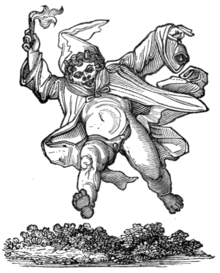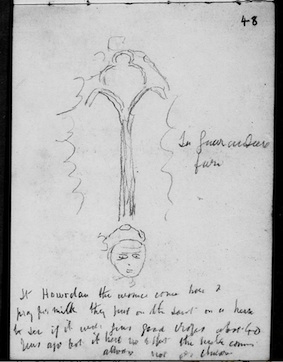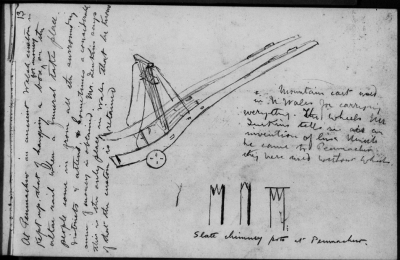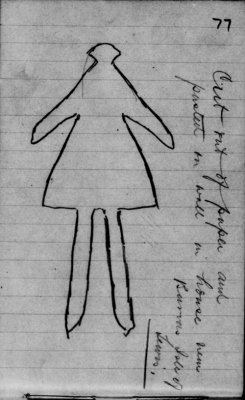To search the RPR site click here
The author was invited to present this paper to the Folklore Society AGM and meeting on 24 April 2009. It received a subdued response from the Folklore Society members, the reasons for which will become clear as you read the paper. Note that the paper was written before the decision taken, at the beginning of this project, to hyphenate Augustus Pitt-Rivers surname: only the title has been changed. In addition the paper was written before the contents of the second collection were known and it therefore does not discuss the folkloric artefacts contained within that collection.
Augustus Henry Lane Fox Pitt-Rivers, the Pitt Rivers Museum and Folklore
Pitt Rivers' obituary was published in Folklore in June 1900, only a little over a month after his death on 4 May. [Gomme, 1900] The obituary starts in a downbeat manner, 'This Society did not directly receive from him assistance in its labours' but then adds, 'but it owes a deep debt of gratitude nevertheless to his encouragement and work in subjects kindred to folklore.' Gomme had visited the General only a month before his death and noted that 'the publications of our Society were conspicuously placed on the book-shelves adjoining his room'. [Gomme, 1900: 185] This paper explores the relationship between Pitt Rivers and folklore. Did Pitt Rivers really 'encourage' and 'work in subjects kindred to folklore'?
Augustus Pitt Rivers was born in 1827, the second son of an aristocratic family. He joined the Army in 1845, eventually rising to the rank of Lieutenant-General. During the 1850s he began to collect both anthropological and archaeological artefacts to illustrate his belief that objects, as well as animals, evolved 'from the simple to the complex, and from the homogeneous to the heterogeneous'. [Lane Fox, 1877: xi] These objects were displayed in the Bethnal Green branch of the South Kensington Museum from 1874 and later at Oxford. From 1880 he lived on his new estate in Dorset and formed a second collection, displayed there at Farnham Museum.
Pitt Rivers was always a keen member of a number of antiquarian and anthropological societies, from the 1850s. His main residence was in London and his professional army career was such that he was able to devote a great deal of his time to his private interests. He was a member of the Society of Antiquaries, the Ethnological Society and Anthropological Institute, Royal Geographical Society, Royal Archaeological Institute, Zoological Society and the Royal United Services Institute among many others. He served on the committees of almost all these societies as well as writing many papers for their journals, and attended their meetings regularly. He was also a leading light of the British Association for the Advancement of Science and a Fellow of the Royal Society.
He retired from the Army in 1882 and his life changed a great deal at this time as his health began to seriously deteriorate:
Having retired from active service on account of ill-health, and being incapable of strong physical exercise, I determined to devote the remaining portion of my life chiefly to an examination of the antiquities on my own property’. [Pitt Rivers: Excavations in Cranborne Chase vol I p.xii quoted in Thompson, 1977: 91]
Unsurprisingly, after 1882 he became a much less active members of his clubs and societies. He spent much more time on his country estate and much less time in London which limited his attendance at meetings. Pitt Rivers only joined the Folklore Society in 1885-6, when the society was some eight years old. It is not known why Pitt Rivers did not join the society before this date as several of his friends and colleagues, for example Edward Burnett Tylor, John Lubbock, John Evans and John Mansel Pleydell, were members from very early on. However, he would have had access to the journals of the Society via the Society of Antiquaries, so perhaps he did not feel the need. It is, therefore, not necessarily because of lack of interest that his links with the Folklore Society were not stronger.
By 1889 Pitt Rivers had been made a member of the Council of the Folklore Society, and in 1890 he was appointed one of four vice-presidents. The others were John Lubbock (his son-in-law and colleague), Edward Burnett Tylor (who had been appointed the first lecturer in anthropology at Oxford in association with the Pitt Rivers Museum) and the Earl Beauchamp. Andrew Lang, another academic associated with the University of Oxford, was the President. The role of Vice-President seems to have been a purely honorary one, intended to add lustre to the name of the Society, rather than requiring any formal duties. He continued to be a vice-president until 1900, the year he died, it was that year that the post of vice-president seems to have disappeared.
Although Pitt Rivers is primarily remembered for his collections, and for his work on the physical nature of artefacts, his membership of the society suggests that he was interested in the more intangible aspects of society and culture as well. Several of the definitions of folklore given in the annual report of the society, in the year he joined, will have presumably interested him:
- 'Folklore is anthropology dealing with primitive man' [Alfred Nutt, 1885: 386];
- 'Folklore is anthropology dealing with the psychological phenomena of uncivilized man' [E. Sidney Hartland, 1885: 386];
- 'The science which treats of the survivals of archaic beliefs and customs in modern ages' [Gomme, 1885: 388];
- 'The science which treats of all that the folk believe or practice on the authority of inherited tradition, and not on the authority of written records'. [Charlotte Burne, 1885: 389]
In the next year's annual report, the Council reported that they hoped to 'issue an authorised Handbook to the Science of Folk-lore, similar to the Anthropological 'Notes and Queries' issued by the British Association for the Advancement of Science'. [p. 370] Although Pitt Rivers had been instrumental in setting up the Notes and Queries, both financing and contributing to its contents, he was not one of the committee identified as being responsible for the Folklore Society's handbook. The Handbook of Folk-Lore was finally published in October 1890:
'The book has been forwarded to every member of the Society, and widely distributed to the press throughout the Country. Arrangements have also been made for placing a certain number of copies at the disposal of members of the Council, and of the Secretary of the Geographical Society, for the use of travellers and others who are likely to assist in the Society's work.' [Annual Report of the Council, 18 March 1891: 502]
It is not recorded what Pitt Rivers thought of the handbook, or whether he ever used it.
In the Folklore journal in 1888 there is an article on Dorset folk-lore that would presumably have interested Pitt Rivers. The Society was much exercised at this period with the need for 'the systematic collection of the remnants of British Folklore and ... the classification of general folklore in such a shape that the scientific value of each item may be tested and examined'. [FLS Annual Report 1889, p. 357] The Council (of which Pitt Rivers had just become a member) had suggested:
'that a more useful method of utililsing local efforts ... might be successfully inaugurated if the members of the Society would constitute local committees for each county. ... the following is the county representation in the Society, upon which it is hoped to base some system of local co-operation. If the members of each county would put themselves in communication with the Council, and act as local representives of the Society, the work of collection might be systematically mapped out, while at the same time the influence of the Society might be very widely extended'. [p. 357-8]
Pitt Rivers was the only name listed under Dorsetshire. [p. 359] However, it seems he did not accept the challenge of collecting local folklore or of coordinating local society members. In the sixteenth annual report, published on 17 January 1894, there is a report of the progress made in the county reports, but Dorset and Pitt Rivers himself are not mentioned. [p. i] Some five years later, some Dorset folklore was published in Folklore by H. Colley March. This had been collected in 1897 as part of the work of the Ethnographical Survey Committee of the British Association. [March, 1899] Pitt Rivers' only mention in this article is to refer to his dating of 'camps' like that at Trendle Hill, to the Bronze Age, and a reference to him 'renovating' the Cerne Giant in 1887. [March, 1899: 478, 482]
The Folklore Society continued to debate what its purpose was. In his Annual Address to the Folklore Society of 26 November 1890, G.L. Gomme stated:
'At first sight we certainly seem to be divided into two camps—the anthropological and the literary ... folk-lore, however and whenever recorded, so long as the record is of itself good, is one of the elements which must be taken into account before the last word has been said on the connection between the prehistoric races and those of history. ... I must confess to a feeling of rather acrimonious jealousy when I see how persistently folk-lore is ignored by authorities in reckoning up the factors which contribute towards the history of prehistoric man. ... Some day it will be recognised that we must appeal to all elements of that history. in the meantime, the conjuction of philology, archaeology, and craniology has brought about a revolution in scientific though as to the prehistoric races in Europe; and my belief is, before anything like good order is again restored after this revolution, folk-lore must be taken into account.' [Gomme, 1891: 2-3]
This section might hint at what interested Pitt Rivers about the proceedings of the Society. He had long believed that the study of ethnographic artefacts might illuminate the past:
‘... the existing races, in their respective stages of progression, may be taken as the bona fide representatives of the races of antiquity; ... They thus afford us living illustrations of the social customs, the forms of government, laws, and warlike practices, which belonged to the ancient races from which they remotely sprung, whose implements, resembling, with but little difference, their own, are now found low down in the soil, in situations, and under circumstances in which, alone, they would convey but little evidence to the antiquary, but which, when the investigations of the antiquary are interpreted by those of the ethnologist, are teeming with interesting revelations respecting the past history of our race, and which, in the hands of the anthropologist, in whose science that of antiquity and ethnology are combined with physiology and geology, is no doubt destined to throw a flood of light, if not eventually, in a great measure, to clear up the mystery which now hangs over everything connected with the origin of mankind.’ [Pitt Rivers, June 28 1867 ‘Primitive Warfare: Illustrated by specimens from the Museum of the Institution’ ‘Primitive Warfare I - III: Lectures delivered at the RUSI’, 8]
Now Gomme was suggesting that contemporary folklore too might make contributions to understanding the past. Gomme also reflected current anthropological interest in survivals, 'folk-lore contains the survivals of the oldest and rudest culture of man.' [Gomme, 1891: 9] A year later, in his next Presidential address, Gomme was again suggesting that folklore had much to contribute to anthropology:
'I believe that folk-lore supplies for the countries of Europe the anthropological data corresponding to what is being collected so assiduously from people who are still in the savage and barbarous stage of culture.' [Gomme, 1892: 4]
Pitt Rivers was, of course, principally known for his application of the theory of evolution to material culture, Gomme picks up on this in his 1892 Presidential address:
'The next principle is that folk-lore cannot by any possibility develop. The doctrine of evolution is so strong upon us that we are apt to apply its leading idea insensibly to almost every branch of human history. But folk-lore, being what it is, namely, the survival of traditional ideas or practices among a people whose principal members have passed beyond the stage of civilisation which those ideas and practices once represented, it is impossible for it to have any development. ...' [Gomme, 1893: 6]
In summary, Pitt Rivers appears, despite the kind words said about him in the Society's obituary, to have been a very 'hands-off' member of the Society, and to have done little as Vice-President except, perhaps, bring some celebrity to the Society because of his prominence in anthropological and archaeological debates in the UK in the 1860s and 1870s. I can find no trace of an article published by him in the Folklore journals, nor can I find any publications of his in other journals that deal with straightforwardly folkloric accounts. In the twenty-third annual report of the Council of the Society given on 16 January 1901, it states:
In the death of Lieut.-General Pitt-Rivers, one of its Vice-Presidents, the Society has shared in a special manner a national loss. His services to archaeology have been duly recorded in the pages of Folk-Lore. Although he never made any communication to the Society, every folklore student owes a great debt of gratitude to his labours, and to the collections at Oxford and at Farnham which he founded. [23rd annual report, 6]
I imagine that it is a bit of a disappointment to present-day members of the Folklore Society, that Pitt Rivers did not make more of his membership and high office. However, this is not the end of the story. Although the accounts of Pitt Rivers' dealings with the society honestly record very little activity, Pitt Rivers had collected many items during his long career, which could be considered folkloric, and it is to these that I will now turn, concentrating on those from Europe for expediency's sake.
There are only a handful English artefacts in the founding collection of the Pitt Rivers Museum which could be called 'folkloric', but several of them are very interesting. Many are discussed in Ellen Ettlinger's [ETT-linger as in tarry, stress on first syllable] article on 'Documents of British superstition in Oxford' published in Folklore in March 1943.
One of the earliest pieces that Pitt Rivers is known to have collected was in 1868. On 26 November he exhibited two rush sticks, one from Surrey and one from Sussex, that he and his friend Arthur Tupper had come across during a walking expedition. Neither of these items were to come to the Pitt Rivers Museum at Oxford. [Lane Fox, 1868: 158-9][Chapman, 1981: 297][Later note: in fact one of them is probably 1884.116.76]
Another early piece was 'fragments of rag used as a votive offering for the cure of diseases at St Helens Well, Thorp Arch Yorkshire at the present time' which Pitt Rivers acquired from Mrs Marianne Cooke in 1869 (about whom we know nothing). [1884.140.331] Oddly, this item was not accessioned into the Pitt Rivers Museum collections until the 1990s though it had lain in the museum for over a hundred years by then. Sometime during the 1920s to 1930s a volunteer at the Pitt Rivers Museum gave more information: the rags were 'hung there by the country people who believe the water is good for eye diseases if combined with an offering of this type to St Helen. They are often left by Roman Catholics being near Clifford where they are numerous'.
The site of the well is close to Boston Spa and Wetherby in North Yorkshire. Ellen Ettlinger mentions the rags in her article:
In pre-Christian days, when wells and trees were identified with spirits, offerings were deposited in their immediate neighbourhood to preserve the contact between the worshipper and the divinity. Since the spread of Christianity the real intention of this rite has been preserved only at those wells, where Christian Saints replaced the well spirit. To quote only instances from the Pitt Rivers Museum, this was the case at St. Helen's Well ... [Ettlinger, 1943: 247-8]
Other accounts of the well mention textiles tied near the well:
Bonser also recalls visiting St Helen's Well ... in the 1930s, when "there were a number of rags and ribbons fluttering from the branches of bushes overhanging the spring which bubbled out of the ground quite close to the banks of the River Wharfe, at a ford where the Roman road, the Rudgate, crossed the river. [http://www.northernearth.co.uk/61leeds.htm]
At least one website image suggests that people still tie things to the tree near the well. This is a subject that has been written about extensively in Folklore including at least two articles published before 1900. Although Pitt Rivers acquired his examples long before most of these authors wrote about them, he must have found them of interest if he recalled the items in his collection.
Another item of folkloric interest was 1884.56.3, described by a museum worker as a 'stone with natural perforation, found fixed on a nail to the cottage-door of Kimber, a carter in General Pitt Rivers' employment, to keep away witches'. This item is particularly interesting as it must have been acquired between 1880, when Pitt Rivers first inherited the Rushmore estate, and 5 April 1881 when he sent the stone to South Kensington Museum (where his collection was then displayed).
Ettlinger also mentions this item:
More frequently, however, holed stones were fastened to the house- or byre-door, as is shown in three examples in the Pitt Rivers Museum, to keep away witches and pixies, or just for good luck. The first was found nailed to the door of a man called Kimber, ... The second served in 1896 in Ballymena (N. Ireland) to prevent pixies from stealing the milk, while the third, a pebble of black limestone, bored by pholas, was hung behind the door of William Twizel's cottage in Newbiggin-by-the-Sea, Northumberland.].' [Ettlinger, 1943: 235]
The original documentation does not mention the name of the carter and it is not clear where the information came from. Ettlinger thanks Tom Penniman, the then curator of the Museum, so he might have been the source though it is unclear where he would have learnt this information from.
This form of amulet is often called a hagstone, again there is a good literature on this type of object. It seems to have been a common Dorset belief. The stone had a natural perforation, or hole, and were often made of flint or polished pebble found washed up on the Dorset coast. As one of the non-scholarly websites puts it:
In bygone days when superstition played a part in everyone's lives, it was common to see these stone baubles hanging above the doors of people's houses, for Hag stones were believed by some to have protective properties from the powerful effects of evil.
On farms it was customary to hang a hag stone on a nail (especially if it was made of iron as this increased the stones power) above the stable door or tied around a horses neck to prevent them from being 'hag rod', a Dorset expression often used to describe when witches stole horses to ride to their sabbats. [http://www.weymouth.gov.uk/home.asp?sv=1125]
As Caroline Oates has more recently written, 'hag-ridden' refers to the 'nightmare, characterised by terror, an impression of being awake but power-less to move or speak, and sensations of weight on the chest. Popular tradition represented such experiences as assaults by witches sitting on sleepers' bellies, inflicting terrifying dreams, and leaving their victims exhausted and haggard ("hag-ridden") in the morning. [Oates, 2003: 205] Holed stones were thus seen as a common counter-charm to deter the 'hag'.
Other items that were part of the founding collection from England and showed Pitt Rivers' interest in such matters are the witchpost [1884.56.80], the memorial biscuits for the Biddenden Maids [1884.56.100] shown here and the many pilgrim tokens and horse brasses.
Pitt Rivers also collected similar items from other parts of Europe. He collected many in France, a country he visited several times —on holiday; while researching archaeological sites; and when attending spas for his health. Many of the folkloric items were collected from Brittany—an area which was viewed at the time, even by the French, as curiously old-fashioned and set in its traditional ways. He presumably collected the items as he travelled between archaeological sites. These pieces include, a 'specimen of staurolite, regarded by Bretons as of supernatural original and to have supernatural powers [1884.56.5] from Auray; a Neolithic celt of ?fibrolite, pierced for suspension from the Ile de Brehat obtained in 1879 [1884.56.18]; a 'linen bag of earth stuck with pins: a charm for fever' thought to be from Brittany [1884.56.22]; several items from St Herbot said to cure diseases [1884.56.24 and 1884.56.27 for example] and several items associated with St Cornely (the protector of animals) to keep cattle from disease [1884.56.25-26] and finally votive offerings (models of various afflected human body parts)[for example 1884.58.104].
We have a little more information about one of these objects, [1884.56.23], a cure for fever from Guincamp. It is a small bag of cotton rag said to contain the pounded-up shells of snails from the walls of St. Leonards Church. It was worn round the neck as a cure for fever. When the cure is effected the bag had to be buried at the foot of the wall of the church, otherwise the fever would return. It was found in the ground beneath the church walls by Pitt Rivers in April 1879.
Pitt Rivers collected artefacts in Ireland when he was serving in the British Army from 1862-66 and stationed near Cork. The items include a 'heart of a deceased person, in heartshaped lead cist: from a niche in oldest church in Cork Ireland'. [1884.57.18]; a 'votive prayer-stick' (a branch with bark) 'with notches in groups of 5 of prayers said, which are left on an island in the lake of Gougan Barra Cork Ireland'. [1884.98.39]
There are also other sets of rags from holy wells, from both France and Ireland. The French one is from a church in Brittany devoted to St Antoine (the town is unnamed), this item was also found unentered in the museum's catalogues in the 1990s. Where the Irish rags were found is not recorded.
Although in retrospect it is hard to see Pitt Rivers' limited contribution as important to the Folk-Lore Society, they very kindly made much of his death. Edwin Sidney Hartland, the retiring President of the society, made it the headline item of his farewell address:
General Pitt-Rivers had been for eleven years a Vice-President of the Society. His chief work, though outside the immediate range of our studies, was of a kind which on the one hand illustrates those studies, and on the other hand receives from them illustration and confirmation. The continuity of tradition was the leading thought of his scientific life. The noble museum at Oxford which bears his name, and is due to his munificence, grew out of that thought; and the other museum, hardly less interesting, on his estate at Farnham is penetrated with the same. If genius be properly defined as the infinite capacity for taking pains, General Pitt-Rivers was endowed with it in ample measure. His motto in everything was Thorough; and it will be of evil augury for British archaeology if the example he set shall ever be lost sight of. He has left to his country and to anthropological science in the two museums and in his writings, not simply a monument to his own fame, but a gift the value of which must grow with the rolling years and our evolving civilisation. [Hartland, 1901: 15-6]
This paper is based on my work, over the last twenty years, on the founding collection of the Pitt Rivers Museum at Oxford, that donated by General Pitt Rivers in 1884. I am pleased to be able to tell you that this work will continue for the next three years. With my colleague Jeremy Coote, I will be working on a Leverhulme Trust-funded project to look in much greater detail at Pitt-Rivers' entire collections, especially those that were acquired after 1880. For the first time this will allow the folkloric (and other) items in the second collection to be catalogued. The link shown on this slide will direct you to the website of this project so you can follow its progress.
Bibliography
Broadwood, Lucy E. 1898 'Pins and Metal in Wells Pins and Metal in Wells' Folklore, Vol. 9, No. 4 (Dec., 1898), p. 368
Chapman, W.R. 1981. Ethnology in the Museum. Unpublished D. Phil thesis, vols I and II, Pitt Rivers Museum, University of Oxford
Ettlinger, Ellen. 1943 'Documents of British Superstition in Oxford' Folklore, Vol. 54, No. 1 (Mar., 1943), pp. 227-249
Fox, A.H. Lane June 28 1867 ‘Primitive Warfare: Illustrated by specimens from the Museum of the Institution’ from ‘Primitive Warfare I - III: Lectures delivered at the RUSI’, reprinted in 1906, Evolution of Culture Oxford: Oxford University Press
Fox, A.H. Lane 1877. Catalogue of the Anthropological Collection Lent by Colonel Lane Fox for exhibition ... Parts I and II' London: Her Majesty's Stationery Office.
Gomme, G. Laurence. 1900. 'Lieut.-General Augustus Pitt-Rivers, D.C.L., F.R.S., F.S.A., etc.' Folklore, Vol. 11, No. 2 (Jun., 1900), pp. 185-187
Gomme, G. Laurence. 1891 'Annual Address to the Folk-Lore Society, Nov. 26, 1890' Folklore, Vol. 2, No. 1 (Mar., 1891), pp. 1-30
Gomme, G. Laurence. 'The President's Address' Folklore, Vol. 3, No. 1 (Mar., 1892), pp. 1-25
Gomme, G. Laurence. 'Annual Address by the President' Folklore, Vol. 4, No. 1 (Mar., 1893), pp. 1-26
Hartland, E. Sidney 1893 Pin-Wells and Rag-Bushes' Folklore, Vol. 4, No. 4 (Dec., 1893), pp. 451-470
Hartland, E. Sidney 1901 'Retiring Presidential Address' Folklore, Vol. 12, No. 1 (Mar., 1901), pp. 15-40
March, H. Colley. 1899. 'Dorset Folklore Collected in 1897' Folklore, Vol. 10, No. 4 (Dec., 1899), pp. 478-489
Oates, Caroline. 2003. 'Cheese Gives You Nightmares: Old Hags and Heartburn' Folklore, Vol. 114, No. 2 (Aug., 2003), pp. 205-225
Tupper, A.C. and A.H. Lane Fox, 1868. 'Exhibition of two rush-sticks, the first from Shere in the County of Surrey; the second from Brombe, Sussex' Proceedings of the Society of Antiquaries of London, 2nd series, 4 (1868) 158-9.
'Seventh Annual Report of the Folklore Society Council, 27th June 1885' The Folk-Lore Journal, Vol. 3, No. 4 (1885), pp. 385-396
'The Folk-Lore Society. Eighth Annual Report of the Council' The Folk-Lore Journal, Vol. 4, No. 4 (1886), pp. 369-374
'The Folk-Lore Society. Annual Report of the Council 26th Novemer 1889' The Folk-Lore Journal, Vol. 7, No. 5 (1889), pp. 357-376
'Annual Report of the Council March 18, 1891' Folklore, Vol. 2, No. 4 (Dec., 1891), pp. 502-508
'Folk-Lore Society. Sixteenth Annual Report of the Council January 17th 1894' Folklore, Vol. 5, No. 4 (Dec., 1894), pp. i-ix
'Twenty-Third Annual Report of the Council 16 January 1901' Folklore, Vol. 12, No. 1 (Mar., 1901), pp. 5-14
AP, April 2009.
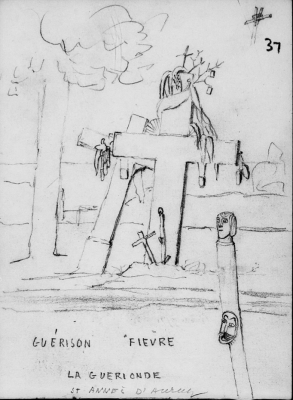 Addendum
Addendum
Added September 2011 by AP
Despite the impression given in the above article, Pitt-Rivers did take an interest in folklore, however, as is shown by the attached illustrations taken from his workbooks held by the National Archives, of things seen during his tours as Inspector of Ancient Monuments at the end of 1878 and beginning of 1879 and in 1885. The following illustrations and text are shown in entirety.

